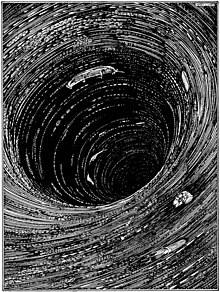Harry Clarke

Harry Clarke (born March 17, 1889 in Dublin , † January 6, 1931 in Chur ) was an Irish glass painter and book illustrator .
life and work
Harry Clarke was born in Dublin, the second son of Joshua and Bridget Clarke. Harry had two sisters, Dolly and Kathleen, and his brother Walter was exactly one year older than him to the day. The brothers' eventual wives were sisters Margaret and Minnie Crilly.
Father Joshua moved from Leeds to Dublin in 1887 as a craftsman restoring church inventory and making glass-painted church windows. From 1892 he set up a workshop in the rooms of his house at 33 North Fredrick Street and founded his own company, which was continued by his sons Harry and Walter after his death in 1921. Harry was fascinated by the work in the workshop from an early age and spent a lot of time there.
He began his school career in the Jesuit- run Belvedere College not far from his parents' home in Dublin. His talent and interest in drawing and art was already evident here. During his training in his father's company, which he began in 1905, he studied glass painting at the Dublin Art School, where he attracted attention by winning several prizes. A scholarship took Clarke in 1910 to London, where he was commissioned by the publisher George G. Harrap and Co , the illustration of works The Rime of the Ancient Mariner by Samuel Taylor Coleridge and an illustrated edition of Alexander Pope 's The Rape of the Lock began , but never finished due to discrepancies.
In 1916 the illustration of Hans Christian Andersen's Fairy Tales became his first printed work, followed by a first illustration of the Tales of Mystery and Imagination by Edgar Allan Poe . The first, still monochrome version of this work was followed by a partially colored edition in 1923.
These first works by Harry Clarke cemented his reputation as a book illustrator. This was followed by the illustrated works The Fairy Tales of Charles Perrault (1920) and Goethe's Faust (1925).
The advertising brochures A History of a Great House (1924) and Elixir of Life (1925), illustrated by Harry Clarke, were created for the spirits manufacturer Jameson Irish Whiskey .
The last book he illustrated, Selected Poems by Algernon Charles Swinburne , was published in 1928.
Like his brother Walter, Harry also suffered from lung problems and was diagnosed with tuberculosis in 1929 . He traveled to Davos in Switzerland for a cure . On his planned return trip to Dublin he died on January 6, 1931 in Chur and was buried there.
The glass paintings he created are still very popular today. His earliest works include the windows in the Honan Chapel, a chapel of the University College in the Irish city of Cork . A work that was completed in 1917.
From 1917 until his untimely death in 1931, Harry Clarke carried out over forty assignments with more than 130 artistically painted windows in Ireland, Great Britain, the British Isles, Australia and Africa.
Works are located at St. Senans Church in Kilrush and St. Ultans Church in Bohermeen County Meath . There are also secular motifs in Bewley's Cafe in Dublin and a motif for John Keats ' The Eve of St. Agnes , which is exhibited in the Dublin City Gallery The Hugh Lane .
Clarke's glass paintings often deal with religious, and more rarely also secular motifs. He designed and designed more than a dozen windows for war memorials and chapels, as well as some works for private individuals. These works were mostly interpretations of poems or ballads in small formats.
Web links
- Harry Clarke Works on Flickr
- Book illustrations by Harry Clarke
- Harry Clarke - Darkness in Light, the life and work of Harry Clarke
- Stained glass by Harry Clarke
- 'Spirit of the Ages' Museum: Harry Clarke Collection
| personal data | |
|---|---|
| SURNAME | Clarke, Harry |
| BRIEF DESCRIPTION | Irish glass painter and book illustrator |
| DATE OF BIRTH | March 17, 1889 |
| PLACE OF BIRTH | Dublin |
| DATE OF DEATH | January 6, 1931 |
| Place of death | Chur |

